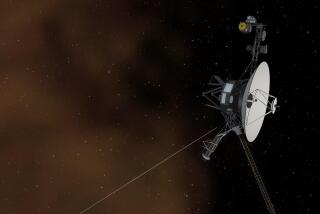Pioneer spacecraft ‘anomaly’ solved, and it’s not new physics
A Jet Propulsion Laboratory researcher has solved the so-called Pioneer anomaly -- the unexpected slowing of the two Pioneer spacecraft -- and shown that it is not due to unknown physics, as some theoreticians had speculated. Instead, it is the result of heat radiated by the spacecraft.
Pioneer 10 and Pioneer 11 were launched in 1972 and 1973, respectively, on a trajectory toward the edge of the solar system. In the early 1980s, controllers at NASA’s JPL detected a slight deceleration in the crafts’ speeds. The effect was initially dismissed as resulting from leftover propellant in the fuel lines, but it persisted much longer than could be accounted for by such a cause. In 1998, John Anderson of JPL and his colleagues calculated that the craft had a deceleration rate of about 300 inches per day. Because they had no explanation for the slowing, the team speculated that it might be caused by some new physics that contradicted Einstein’s general theory of relativity.
In 2004, Slava Turyshev contemplated constructing a new probe to examine the effect, but first decided to scrutinize the data from the two Pioneers more thoroughly to try to resolve the mystery without building a spacecraft. He collected data from around the country, much of it on computer punch cards. He also found dozens of boxes of magnetic tapes stored under a staircase at JPL, as well as magnetic optical tapes from NASA’s Ames Research Center at Moffett Field in Northern California. He also managed to salvage a vintage tape machine that was about to be discarded. A programmer in Canada, Viktor Toth, contacted Turyshev and helped create a program that could read the tapes and clean up the data.
The team reported in the journal Physical Review Letters that they were able to calculate the amount of heat generated by the electrical subsystems of the craft and the decay of plutonium in the power sources. They concluded that the radiation of that heat in the direction of the spacecraft’s travel was sufficient to explain the slight deceleration. “The effect is something like when you are driving a car and the photons from your headlights are pushing you backward,” Turyshev said. “It’s very subtle.”
The effect is not seen in other spacecraft because of the way they are built. The Pioneers spin on their axes, while others, such as Voyager, are kept aligned in three dimensions by thrusters.
“The story is finding its conclusion because it turns out that standard physics prevail,” Turyshev said. “While of course it would’ve been exciting to discover a new kind of physics, we did solve a mystery.”
Twitter/@LATMaugh





